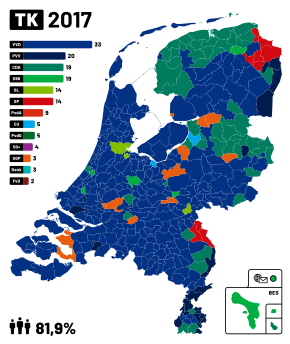Dutch general election, 2017
|
|||||||||||||||||||||||||||||||||||||||||||||||||||||||||||||||||||||||
| Turnout | 81.9% (official) | ||||||||||||||||||||||||||||||||||||||||||||||||||||||||||||||||||||||
|---|---|---|---|---|---|---|---|---|---|---|---|---|---|---|---|---|---|---|---|---|---|---|---|---|---|---|---|---|---|---|---|---|---|---|---|---|---|---|---|---|---|---|---|---|---|---|---|---|---|---|---|---|---|---|---|---|---|---|---|---|---|---|---|---|---|---|---|---|---|---|---|
This lists parties that won seats. See the complete results below.
|
|||||||||||||||||||||||||||||||||||||||||||||||||||||||||||||||||||||||

Strongest political party by municipality
|
|||||||||||||||||||||||||||||||||||||||||||||||||||||||||||||||||||||||
|
|||||||||||||||||||||||||||||||||||||||||||||||||||||||||||||||||||||||
General elections were held in the Netherlands on Wednesday 15 March 2017 to elect all 150 members of the House of Representatives.
This was the first election called because of completion of the previous government's four-year term (rather than the resignation of the cabinet) since 2002. The 2012 elections had resulted in a ruling coalition of Prime Minister Mark Rutte's People's Party for Freedom and Democracy (VVD) and the Labour Party (PvdA). Because the second Rutte cabinet lacked a majority in the Senate, it relied on the support of Democrats 66 (D66), the Christian Union (CU) and the Reformed Political Party (SGP).
Preliminary results and exit polls for the 2017 election showed that the VVD lost some seats, but retained their position as largest party, while the PvdA saw a massive loss in vote share and seats, failing to win a single municipality for the first time in the party's history. The Party for Freedom (PVV) made gains to reach second place, with the CDA, D66 and GroenLinks also increasing their number of seats. At least four partners will be needed for a coalition with a parliamentary majority. The official election results were certified and published on 21 March. The elected MPs took their seats on 23 March.
The House of Representatives, or Second Chamber (Tweede Kamer) is composed of 150 seats elected by proportional representation in a single nationwide constituency, with a legal threshold of 1 full seat (0.67%), and residuals assigned by the D'Hondt method.Electronic voting has been banned since 2007 and votes must be cast with a red pencil.
...
Wikipedia

